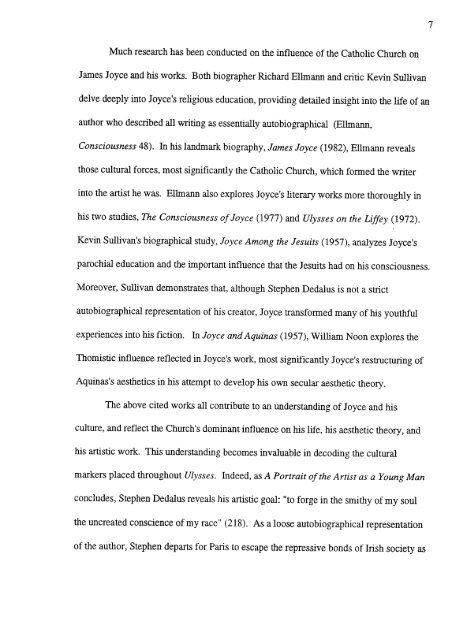Faubourg Saint Patrice - ScholarsArchive at Oregon State University
Faubourg Saint Patrice - ScholarsArchive at Oregon State University
Faubourg Saint Patrice - ScholarsArchive at Oregon State University
Create successful ePaper yourself
Turn your PDF publications into a flip-book with our unique Google optimized e-Paper software.
Much research has been conducted on the influence of the C<strong>at</strong>holic Church on<br />
James Joyce and his works. Both biographer Richard Ellmann and critic Kevin Sullivan<br />
delve deeply into Joyce's religious educ<strong>at</strong>ion, providing detailed insight into the life of an<br />
author who described all writing as essentially autobiographical (Ellmann,<br />
Consciousness 48). In his landmark biography, James Joyce (1982), Ellmann reveals<br />
those cultural forces, most significantly the C<strong>at</strong>holic Church, which formed the writer<br />
into the artist he was. Ellmann also explores Joyce's literary works more thoroughly in<br />
his two studies, The Consciousness of Joyce (1977) and Ulysses on the Liffey (1972).<br />
Kevin Sullivan's biographical study, Joyce Among the Jesuits (1957), analyzes Joyce's<br />
parochial educ<strong>at</strong>ion and the important influence th<strong>at</strong> the Jesuits had on his consciousness.<br />
Moreover, Sullivan demonstr<strong>at</strong>es th<strong>at</strong>, although Stephen Dedalus is not a strict<br />
autobiographical represent<strong>at</strong>ion of his cre<strong>at</strong>or, Joyce transformed many of his youthful<br />
experiences into his fiction. In Joyce and Aquinas (1957), William Noon explores the<br />
Thomistic influence reflected in Joyce's work, most significantly Joyce's restructuring of<br />
Aquinas's aesthetics in his <strong>at</strong>tempt to develop his own secular aesthetic theory.<br />
The above cited works all contribute to an understanding of Joyce and his<br />
culture, and reflect the Church's dominant influence on his life, his aesthetic theory, and<br />
his artistic work. This understanding becomes invaluable in decoding the cultural<br />
markers placed throughout Ulysses. Indeed, as A Portrait of the Artist as a Young Man<br />
concludes, Stephen Dedalus reveals his artistic goal: "to forge in the smithy ofmy soul<br />
the uncre<strong>at</strong>ed conscience of my race" (218). As a loose autobiographical represent<strong>at</strong>ion<br />
of the author, Stephen departs for Paris to escape the repressive bonds of Irish society as<br />
7















